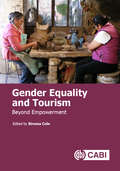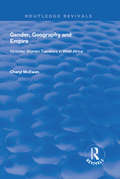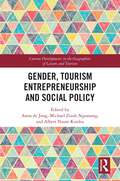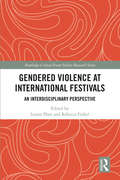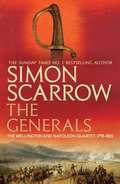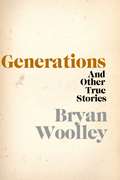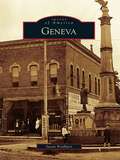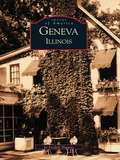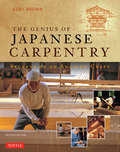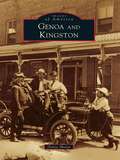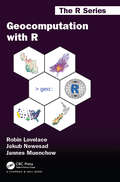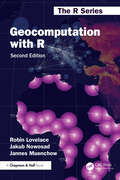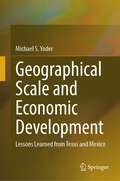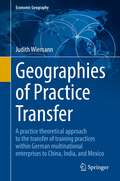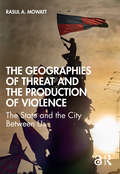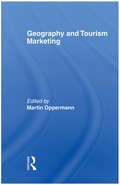- Table View
- List View
Gender Equality and Tourism: Beyond Empowerment
by Stroma Cole Lucy Ferguson Daniela Moreno Alarcón Carlos Costa Marília Durão Zélia Breda Fiona Eva Bakas Paola Vizcaino Suárez Belén Martínez Caparrós Meghan Muldoon Wendy Wendy Kylie Radel Heather Jeffrey Isis Arlene Díaz-Carrión Hazel Tucker Inês CarvalhoDoes tourism empower women working in and producing tourism? How are women using the transformations tourism brings to their advantage? How do women, despite prejudice and stereotypes, break free, resist and renegotiate gender norms at the personal and societal levels? When does tourism increase women's autonomy, agency and authority? The first of its kind this book delivers: A critical approach to gender and tourism development from different stakeholder perspectives, from INGOs, national governments, and managers as well as workers in a variety of fields producing tourism. Stories of individual women working across the world in many aspects of tourism. A foreword by Margaret Bryne Swain and contributions from academics and practitions from across the globe. A lively and accessible style of writing that links academic debates with lived realities while offering hope and practical suggestions for improving gender equality in tourism. Gender Equality and Tourism: Beyond Empowerment, a critical gendered analysis that questions the extent to which tourism brings women empowerment, is an engaging and thought-provoking read for students, researchers and practitioners in the areas of tourism, gender studies, development and anthropology. To access a presentation delivered by Stroma Cole as well as an interview with her, please visit http://www.cabi.org/openresources/94422
Gender Equality and Tourism: Beyond Empowerment
by Lucy Ferguson Daniela Moreno Alarcón Carlos Costa Marília Durão Zélia Breda Fiona Eva Bakas Paola Vizcaino-Suárez Belén Martínez Caparrós Meghan Muldoon Wendy Wendy Kylie Radel Heather Jeffrey Isis Arlene Díaz-Carrión Hazel Tucker Inês CarvalhoDoes tourism empower women working in and producing tourism? How are women using the transformations tourism brings to their advantage? How do women, despite prejudice and stereotypes, break free, resist and renegotiate gender norms at the personal and societal levels? When does tourism increase women's autonomy, agency and authority? The first of its kind this book delivers: A critical approach to gender and tourism development from different stakeholder perspectives, from INGOs, national governments, and managers as well as workers in a variety of fields producing tourism. Stories of individual women working across the world in many aspects of tourism. A foreword by Margaret Bryne Swain and contributions from academics and practitions from across the globe. A lively and accessible style of writing that links academic debates with lived realities while offering hope and practical suggestions for improving gender equality in tourism. Gender Equality and Tourism: Beyond Empowerment, a critical gendered analysis that questions the extent to which tourism brings women empowerment, is an engaging and thought-provoking read for students, researchers and practitioners in the areas of tourism, gender studies, development and anthropology. To access a presentation delivered by Stroma Cole as well as an interview with her, please visit http://www.cabi.org/openresources/94422
Gender, Geography and Empire: Victorian Women Travellers in Africa
by Cheryl McEwanThis title was first published 2000: This text is intended to draw together two important developments in contemporary geography: firstly, the recognition of the need to write critical histories of geographical thought and, particularly, the relationship between modern geography and European imperialism; and secondly, the attempt by feminist geographers to countervail the absence of women in the histories. The author focuses on the narratives of British women travellers in West Africa between 1840 and 1915, exploring their contributions to British imperial culture, teh ways in which they wer empowered in the imperial context by virtue of both "race" and class, and their various representations of West African landscapes and peoples. The book argues for the inclusion of women and their experiences in histories of geographical thought and explores the possibilities and problems of combining feminist and post-colonial approaches to these histories.
Gender, Tourism Entrepreneurship and Social Policy (Current Developments in the Geographies of Leisure and Tourism)
by Anna De Jong Michael Zisuh Ngoasong Albert Nsom KimbuThis timely volume is a novel and important contribution to scholarly literature on gender and tourism entrepreneurship, utilising feminist and post‑colonial frameworks to interrogate the role of social policies in facilitating inclusive tourism entrepreneurship.Drawing on contributions and case studies from across the Global South and Global North, this multi‑disciplinary collection identifies how regional variations in governance and policy influence the experiences and potentialities of tourism entrepreneurship as a promised avenue for inclusive growth for marginalised identities. Problematizing universalised constructions of entrepreneurs as necessarily masculine, western, and driven only by economic imperatives that seek to fix and dislocate entrepreneurial support, this volume takes focus with place‑based approaches to explore the intersections between identity, tourism entrepreneurship and social policy. It is this geographically informed perspective that seeks to account for the complexity of entrepreneurial experience, and the role of social policy within this, that constitutes an original contribution to the field. The focus on gender and social policy reflects the increasing importance of tourism entrepreneurship within the context of the UNWTOs Sustainable Development Goals.This book will be a pivotal resource for students, researchers, academics and policy makers in tourism, gender studies, development studies, sustainability and business.
Gendered Violence at International Festivals: An Interdisciplinary Perspective (Routledge Critical Event Studies Research Series.)
by Louise Platt Rebecca FinkelGendered Violence at International Festivals is a groundbreaking collection that focusses on this highly important social issue for the first time. Including a diverse range of interdisciplinary studies on the issue, the book contests the widely held notion that festivals are temporal spaces free from structural sexism, inequalities or gender power dynamics. Rather, they are spaces where these concerns are enhanced and enacted more freely and where the experiential environment is used as an excuse or as an opportunity to victim blame and shame. In this emerging and under-researched area, the chapters not only present original work in terms of topics but also in theoretical and methodological approaches. All of the chapters are cross- or interdisciplinary, drawing on gender, sexualities, cultural and ethnicity studies. Studies from a range of highly regarded academics based around the world examine the subject by looking at examples from a wide range of destinations, including Spain, Argentina, Nigeria, Zimbabwe, Australia, Canada and the UK. This significant book progresses understanding and debates about gendered festival experiences and emphasises the symbolic and physical violence often associated with them. This will be of great interest to, undergraduate and postgraduate students and academics in the field of Events Studies. It will also be of use to practitioners or non-profit workers in the festival industries, including festival management organisations and planning committees.
The Generals: (Revolution 2) (Revolution #2)
by Simon ScarrowTHE GENERALS is the compelling second novel in Simon Scarrow's bestselling Wellington and Napoleon quartet. A must read for fans of Robert Harris.In the turbulent aftermath of the French Revolution Napoleon Bonaparte stands accused of treachery and corruption. His reputation is saved by his skill in leading his men to victory in Italy and Egypt. But then he must restore order in France and find peace or victory over her enemies: England - and Arthur Wellesley (the future Duke of Wellington).Wellesley is leading a vast army in India, where British interests are under threat. The campaign will result in the creation of the Raj - the jewel in the British Empire's crown. Wellesley returns to England a hardened veteran and more determined than ever to end France's domination of Europe.Both Wellesley and Napoleon intend to win - whatever the cost. Who will ultimately succeed?
The Generals (Wellington and Napoleon 2)
by Simon ScarrowTHE GENERALS is the compelling second novel in Simon Scarrow's bestselling Wellington and Napoleon quartet. A must read for fans of Bernard Cornwell.In the turbulent aftermath of the French Revolution Napoleon Bonaparte stands accused of treachery and corruption. His reputation is saved by his skill in leading his men to victory in Italy and Egypt. But then he must restore order in France and find peace or victory over her enemies: England - and Arthur Wellesley (the future Duke of Wellington).Wellesley is leading a vast army in India, where British interests are under threat. The campaign will result in the creation of the Raj - the jewel in the British Empire's crown. Wellesley returns to England a hardened veteran and more determined than ever to end France's domination of Europe.Both Wellesley and Napoleon intend to win - whatever the cost. Who will ultimately succeed?
Generation Z Marketing and Management in Tourism and Hospitality: The Future of the Industry
by Nikolaos Stylos Roya Rahimi Bendegul Okumus Sarah WilliamsGeneration Z (Gen Z) is the demographic cohort also known as Post-Millennials, the iGeneration or the Homeland Generation. Referring to individuals born roughly between the mid-1990s and the early 2000s, they are our youngest consumers, students, colleagues, and voters. Understanding them is a key aspect. In the context of the hospitality and tourism, Gen Z-ers represent the future in human resources, and service production and consumption. This book focuses on the aspirations, expectations, preferences and behaviours related to individuals within this demographic. It critically discusses their dynamism in driving the tourism sector and offers insights into the roles that Gen Z will inhabit as visitors, guests, consumers, employees, and entrepreneurs. This book is a valuable resource for managers, scholars and students interested in acquiring concrete knowledge on how Gen Z will shape the marketing and management of tourism-related services.
Generations and Other True Stories
by Bryan WoolleyIn this volume of twenty-five pieces, Bryan Woolley explores Dashiell Hammett' San Francisco, recalls the lost golden age of Mineral Well, Texas; returns to the site of a mysterious 1947 crash, believed to be a UFO, in Roswell, New Mexico; and attends a "bulldogging" school in Madisonville, Texas. He meets such people as Kinky Friedman, musician and mystery writer; talks to the residents of Alpine, Texas, about their famous newcomer, Robert James Waller, author of Bridges of Madison County, and mourns the retirement of cartoonist Gary Larson.
Generations of Somerset Place: From Slavery to Freedom (Images of America)
by Dorothy Spruill RedfordWhen the institution of slavery ended in 1865, Somerset Place was the third largest plantation in North Carolina. Located in the rural northeastern part of the state, Somerset was cumulatively home to more than 800 enslaved blacks and four generations of a planter family. During the 80 years that Somerset was an active plantation, hundreds of acres were farmed for rice, corn, oats, wheat, peas, beans, and flax. Today, Somerset Place is preserved as a state historic site offering a realistic view of what it was like for the slaves and freemen who once lived and worked on the plantation, once one of the Upper South's most prosperous enterprises.
Geneva (Images of America)
by Susan BradburnThe area's first settlers, Theobalt Bartholomew and his family, left Charlotte, New York, and arrived on South Ridge Road near Cowles Creek in 1805. Geneva, however, was named by another early settler, Maj. Levi Gaylord, who suggested naming it after the small, beautiful town of Geneva, New York. By the mid-1800s, word traveled back to the East Coast of the fertile soil in Ohio, and soon many farmers came on horseback, in oxcarts, and on foot, driving herds of cattle to the area, and the population grew to about 150. The area along Lake Erie soon became a popular tourist destination with its grape-growing industry, Ohio's first resort, and fishing in the Grand River. The area prospered into a community united by work, recreation, and sport. This collection of historic images highlights the histories of Geneva, Geneva on the Lake, and Harpersfields from 1805 to the present day.
Geneva: 1940-1970
by Geneva Historical SocietyLike many American towns, Geneva changed dramatically in the mid-20th century. Geneva: 1940-1970 examines events that influenced the city, among them the influx of sailors and workers at the nearby Sampson Naval Training Station during World War II and the construction of the Routes 5 and 20 bypass in the 1950s. Many factories ceased operation during this time, and downtown businesses began feeling pressure from a new shopping plaza and stores on the edge of town. The book also captures the social life of the community and notable people who visited Geneva, such as Bobby Kennedy and Jane Russell, and those who grew up here, such as legendary jazz bassist Scott LaFaro.
Geneva: 1940-1970 (Images of America)
by Geneva Historical SocietyGeneva lies in the heart of the Finger Lakes region at the top of Seneca Lake, which is important to the community for both transportation and leisure. With more than two hundred vintage images, Geneva presents a well-researched overview of the town's past, from its settlement in the 1790s to 1940. Pictured are some of the architectural gems that became the cultural cornerstones of a thriving place-the Smith Opera House, the Richard Upjohn-designed Blackwell House and St. John's Chapel on the Hobart & William Smith campus, as well as some of the remarkable people who lived here: Dr. Elizabeth Blackwell, the first woman in the country to receive a medical degree; Henry McDonald, one of the first African American professional football players; Arthur Dove, America's first modernist painter; and Joseph Swift, the first graduate of West Point.
Geneva, Illinois (Images of America)
by Jo Fredell HigginsThe essence of Geneva lies in the city's distinctive hometown quality and relaxed atmosphere. Visitors sense a slower pace and tender ambience that flourished even before Geneva was platted on May 3, 1837. Geneva, Illinois presents a remarkable portrait of the community's earliest beginnings and present-day charms. Geneva offers the vintage flavor of an historic city as well as the contemporary feel of a modern community. In this collection you will find early portraits of education, when lessons were taught in the dining room of a local hotel, along with scenes that celebrate the lush riverbanks upon which residents and guests have enjoyed picnics for more than a hundred years. From the flowers picked at Wheeler Park to the moving pictures of the Optigraph, from the wooden ice cabinets of 1884 to the sidewalk cafes of today, Geneva has flourished.
Genius and Discovery: Five Historical Miniatures
by Stefan Zweig Anthea BellOne of two beautifully designed hardback gift editions of Stefan Zweig's breathlessly dramatic historical sketches, out in time for the holidays.Millions of people in a nation are necessary for a single genius to arise, millions of tedious hours must pass before a truly historic shooting star of humanity appears in the sky.Five vivid dramatizations of some of the most pivotal episodes in human history, from the Discovery of the Pacific to the composition of the Marseillaise, bringing the past to life in brilliant technicolor.Included in this collection:"Flight into Immortality": Vasco Núñez de Balboa's quest to be the first European to see the Pacific Ocean. "The Resurrection of George Frederic Handel": Handel falls into depression until a poet sends him an inspirational work."The Genius of a Night": Captain Rouget writes La Marseillaise, the song which is to become the French national anthem."The Discovery of El Dorado": John Sutter founds New Helvetia in western America and attempts to keep it."The First Word to Cross the Ocean": Cyrus W. Field resolves to lay the first trans-Atlantic telegraph cable.
The Genius of Japanese Carpentry
by Azby BrownThis new edition of this Azby Brown architecural classic contains a new preface by Brown, fully revised chapters, along 25% new photography and in color for the first time.An extraordinary and ambitious work of architectural reconstruction is underway in twenty-first century Nara. The Genius of Japanese Carpentry is the story of the twelve-hundred-year-old Yakushiji monastery and the dedicated modern-day craftsmen who are working to restore what has been lost to the depredations of time, fire, and warfare.In the eighth century, anonymous carpenters first erected the intricately-designed timber temples and pagodas that compose the Yakushiji Buddhist monastery. Then as today, these buildings were considered marvels of architectural elegance and traditional Japanese craftsmanship. Although the full restoration will not be complete until 2030, one of the main temples, the Picture Hall, has been completely reconstructed, employing the original methods, architectural style, and largely the same woodworking technology as its predecessors. Azby Brown chronicles the Picture Hall's painstaking restoration through photographs, extensive interviews with the carpenters and woodworkers, and original drawings based on the plans of Japanese master carpenter Tsunekazu Nishioka. An inspiring testament to the craftsmen, their dedication to excellence, and their philosophy of work as personal fulfillment, The Genius of Japanese Carpentry offers detailed documentation of this singular project and a moving reminder of the humanity that bridges past and present.
Genoa and Kingston
by Denise MoranIn 1835, while Charles Darwin aboard the HMS Beagle was exploring the Galapagos Islands, the northern Illinois municipalities of Genoa and Kingston were being settled. Pioneers arrived via the historic Chicago-Galena stagecoach trail. Thomas Matteson, a Revolutionary War soldier from Ohio, and his family traveled in three covered wagons and became Genoa's first settlers. Genoa was incorporated as a village in 1876 and as a city in 1911. Kingston became a village in 1886. In addition to sharing a boundary, the municipalities share the Genoa-Kingston Fire Department, Genoa-Kingston Middle School, and Genoa-Kingston High School. During the Civil War, 109 men from Genoa and 105 men from Kingston, roughly a tenth of the population of each municipality at that time, enlisted in the Union Army. Men and women from Genoa and Kingston have continued to serve in the U.S. military from World Wars I and II to the wars in Iraq and Afghanistan.
A Gentleman from Japan: The Untold Story of an Incredible Journey from Asia to Queen Elizabeth’s Court
by Thomas LockleyAn incredible sea story that turns the Age of Exploration on its head, following the first Japanese man to set foot on North America and England. On November 12, 1588, five young Asian men—led by a twenty-one-year-old called Christopher—traveled up the River Thames to meet Queen Elizabeth I. Christopher&’s epic sea voyage had spanned from Japan, via the Philippines, New Spain (Mexico), Java and Southern Africa. On the way, he had already become the first recorded Japanese person in North America. Now Christopher was the first ever Japanese visitor to England, and no other would leave such a legacy for centuries to come. The story of Christopher is almost utterly forgotten and has never been fully told before.A Gentleman from Japan is a fast-paced, historical narrative of adventure, cross-cultural endeavor, intellectual exchange, perseverance, espionage and conflict in the Age of Exploration.
Geocomputation with R (Chapman & Hall/CRC The R Series)
by Robin Lovelace Jakub Nowosad Jannes MuenchowGeocomputation with R is for people who want to analyze, visualize and model geographic data with open source software. It is based on R, a statistical programming language that has powerful data processing, visualization, and geospatial capabilities. The book equips you with the knowledge and skills to tackle a wide range of issues manifested in geographic data, including those with scientific, societal, and environmental implications. This book will interest people from many backgrounds, especially Geographic Information Systems (GIS) users interested in applying their domain-specific knowledge in a powerful open source language for data science, and R users interested in extending their skills to handle spatial data. The book is divided into three parts: (I) Foundations, aimed at getting you up-to-speed with geographic data in R, (II) extensions, which covers advanced techniques, and (III) applications to real-world problems. The chapters cover progressively more advanced topics, with early chapters providing strong foundations on which the later chapters build. Part I describes the nature of spatial datasets in R and methods for manipulating them. It also covers geographic data import/export and transforming coordinate reference systems. Part II represents methods that build on these foundations. It covers advanced map making (including web mapping), "bridges" to GIS, sharing reproducible code, and how to do cross-validation in the presence of spatial autocorrelation. Part III applies the knowledge gained to tackle real-world problems, including representing and modeling transport systems, finding optimal locations for stores or services, and ecological modeling. Exercises at the end of each chapter give you the skills needed to tackle a range of geospatial problems. Solutions for each chapter and supplementary materials providing extended examples are available at https://geocompr.github.io/geocompkg/articles/.
Geocomputation with R (Chapman & Hall/CRC The R Series)
by Robin Lovelace Jakub Nowosad Jannes MuenchowGeocomputation with R is for people who want to analyze, visualize, and model geographic data with open source software. The book provides a foundation for learning how to solve a wide range of geographic data analysis problems in a reproducible, and therefore scientifically sound and scalable way. The second edition features numerous updates, including the adoption of the high-performance terra package for all raster data processing, detailed coverage of the spherical geometry engine s2, updated information on coordinate reference systems and new content on openEO, STAC, COG, and gdalcubes. The data visualization chapter has been revamped around version 4 of the tmap package, providing a fresh perspective on creating publication-quality maps from the command line. The importance of the book is also highlighted in a new foreword by Edzer Pebesma.The book equips you with the knowledge and skills necessary to tackle a wide range of issues manifested in geographic data, including those with scientific, societal, and environmental implications. The book is especially well-suited to: Data scientists and engineers interested in upskilling to handle spatial data. People with existing geographic data skills interested in developing powerful geosolutions via code. Anyone who needs to work with spatial data in a reproducible and scalable way. The book is divided into three parts: Foundations, Extensions, and Applications, covering progressively more advanced topics. The exercises at the end of each chapter provide the necessary skills to address various geospatial problems, with solutions and supplementary materials available at r.geocompx.org/solutions/.
Geographical Scale and Economic Development: Lessons Learned from Texas and Mexico
by Michael S. YoderThis book is an attempt to bridge the academic discipline of economic geography with the professional field of economic development. Through case studies of economic development, it illustrates two fundamental concepts of the sub-discipline of economic geography: scale and spatial connections. It demonstrates some of the ways that economic development policies and plans are linked globally, nationally, regionally, and locally. It ties together several studies of communities and transportation systems in Texas and Mexico carried out from the late 2010’s through 2021. The studies shed light on the need to study economic development at multiple scales and to do so through blended qualitative research methods that include conversations with economic development stakeholders, published data, news content from the business and trade media, and direct observation of the built environment.The book is a set of narratives that combine descriptions of the evolution of commercial transportation systems, economic promotion in selected communities, and corresponding changes in the built environment. It is organized into three sections, each of which corresponds to a different scale at which economic development functions: macro, regional, and local.
Geographies of Practice Transfer: A practice theoretical approach to the transfer of training practices within German multinational enterprises to China, India, and Mexico (Economic Geography)
by Judith WiemannEmploying a practice theoretical approach, this study centers on how German multinational enterprises transfer three selected production-related training practices to their subsidiaries in emerging economies: onboarding of new employees, shop floor inducting of machine operators, and German-style dual apprenticeship training for specialized technicians. Empirical findings are drawn from three research regions: Greater Shanghai Area (China), Metropolitan Areas Mumbai-Pune-Bangalore (India), and Central Mexico (Mexico).In doing so, this study contributes to debates about the internationalization of multinational enterprises conceptualizing internationalization through the lens of practice transfer. Practice transfer is still an understudied phenomenon in economic geography while international business studies have a long-standing research interest in this area. This study provides a bridge between these two disciplinary fields connecting debates in economic geography on proximity/distance and knowledge transfer with organization studies-based research in international business studies – all the while providing a unique new perspective by developing a practice theoretical approach to explain practice transfer across distance and between territories.
The Geographies of Threat and the Production of Violence: The State and the City Between Us
by Rasul A MowattThe Geographies of Threat and the Production of Violence exposes the spatial processes of racialising, gendering, and classifying populations through the encoded urban infrastructure – from highways cleaving neighbourhoods to laws and policies fortifying even more unbreachable boundaries. This synthesis of narrative and theory resurrects neglected episodes of state violence and reveals how the built environment continues to enable it today within a range of cities throughout the world. Examples and discussions pull from colonial pasts and presents, of old strategic settlements turned major modern cities in the United States and elsewhere that link to the physical and legal structures concentrating a populace into neighbourhoods that prep them for a lifetime of conscripted and carceral service to the State.
Geography and Tourism Marketing
by Kaye Sung ChonTourism is an extremely challenging business. Some strategies work phenomenally well sometimes and fail at others. You may be aware of the increased fragmentation of the consumer market and of the important role geography plays in tourist response but have difficulty finding a pattern to this without doing a lot of research. Geography and Tourism Marketing will provide you with diverse studies through which you will gain a better understanding of what excites and entices all types of consumers along with new strategies in your field to keep you up-to-date in the unpredictable business of tourism.Geography and Tourism Marketing is a compilation of greatly varied and valuable case studies and articles. In it you’ll explore thought-provoking topics such as these: the World Wide Web as one of the most significant technological developments in travel and tourism marketing the advantages of understanding the impact that a tourist’s country of origin has on small island destinations pinpointing problems in a specific business venture so you can avoid similar mistakes providing interactive maps to potential consumers through Geographic Information Systems determining the effectiveness of brochures reformulating and promoting a consistent image of a destination in order to better serve consumers the fast-growing market of nature travelers and how they can be targeted more effectivelyIn this book, you will get current information on the link between geography and tourism marketing, which is an important aspect in conquering market segmentation and improving tourism marketing approaches. You will see the necessity of acknowledging this connection and be prepared to respond to it when you read Geography and Tourism Marketing.
The Geography of Bliss: One Grump's Search for the Happiest Places in the World
by Eric WeinerWeiner investigates why some places are happy, notably the Netherlands, Switzerland, Bhutan, Qatar, Iceland, Moldova, Thailand, Great Britain, India, and America.
